The kilogram is currently defined, as you well note, as exactly the mass of the International Prototype Kilogram, and by definition the mass of the IPK is $1\:\mathrm{kg}$ with zero error.
This definition took over from the previous one (the mass of $1\:\mathrm{dm}^3$ of water at $4°\mathrm C$ and sea-level pressure) because the previous one was hard to implement in a reproducible and stable manner, and it was easier to simply have a set reference standard. At the time the kilogramme des Archives was instituted, it coincided with the water-based definition to within the available experimental precision - it was just more stable and easier to use. (Later on there was a change to a second standard, the IPK, which simply reflected better technology to make the standard stable.)
However, as you note again, the mass of the IPK and its replicas is subject to change over time: they lose mass when they're polished, and they gain mass through corrosion from air. This is in fact a problem: when sister copies are compared to each other and to the IPK, their mass changes by a few tens of micrograms over the decades:

This has some pretty profound consequences for all of metrology, because it means that mass standards are only stable to roughly the $10^{-8}$ level on decade-long timescales. In turn, that affects every measurement that depends on the mass standard to a finer precision.
Does this sort of thing bother metrologists? You bet it does. Unfortunately, until recently there simply wasn't any suitable alternative - there wasn't any suitable measurement of mass that was precise and stable enough to compete with the IPK. That feels weird (surely we can do better than $10^{-8}/\mathrm{decade}$) but that's how it is.
Note, however, the "until recently" - because now we do have better measurements available, and there is a process in motion to overhaul most of the existing SI. In particular, this includes changing the artifact-based SI to a definition that explicitly sets a value for the reduced Planck constant $\hbar$, and uses this to calibrate mass standards, primarily through the use of a watt balance. For more details on the proposed implementations for this, see What are the proposed realizations in the New SI for the kilogram, ampere, kelvin and mole?What are the proposed realizations in the New SI for the kilogram, ampere, kelvin and mole?.
That said, the IPK is definitely not obsolete at the moment, despite its shortcomings - it will only become obsolete once it's replaced by a renewed definition of the kilogram in ~2018.
